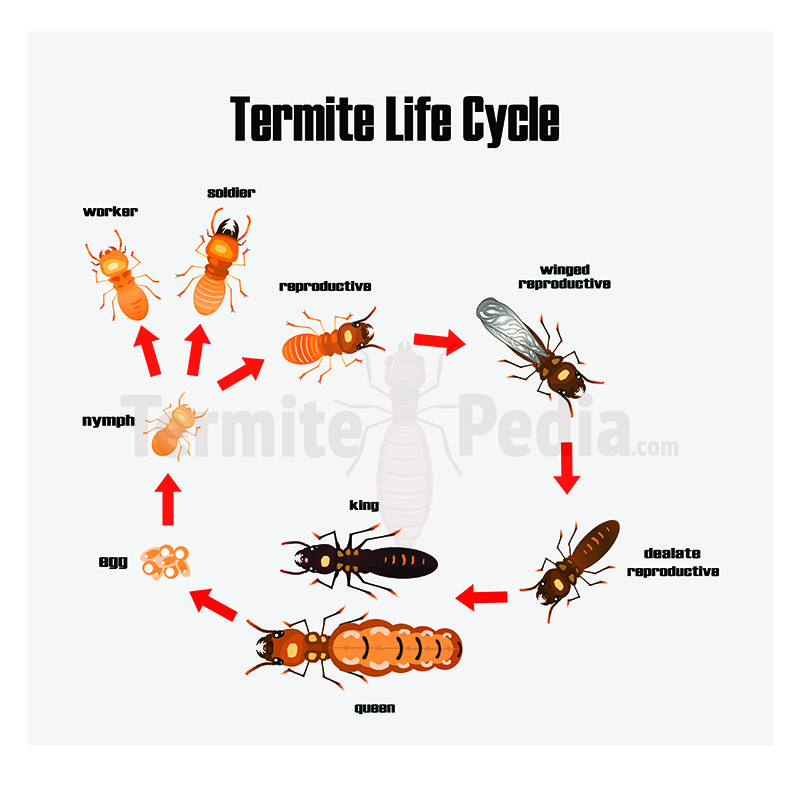
Termite 101 – Your Ultimate, Super Informative Termite Guide You’ve Been Missing!
Welcome to termitepedia.com, a website that will inform you about everything you need to know about termites, including guides to eradicating them completely!
In the pages of this website, you will find out all of the basics about termites. Everything from how to identify the species of termite that you might be running up against, to how you can tell if your house is infested with them, to DIY improvements you can do to keep them from getting in.
After reading our site you are armed with the knowledge to eradicate the termite threat from your home, garden, and your life, you’ll be mentally equipped to indulge in at termite treatment at home.
you’ll learn skills like building a solid defense and prevention against termites, keeping an eye out for them, knowing what to do if you happen to see one, and knowing when and who to call if that ever happens.
You’ll gather enough knowledge to know the best ways to prevent termite infestation, and ultimately how to completely get rid of them.
What are Termites?
What are termites? Termites are wood-eating pests, they are usually considered to be a big pest to humans. Termites are considered to be a pest to humans for good reason, it is estimated that termites can cause Americans $1 billion dollars a year in damages.
Despite being wood-eating, destructive, pests they are fascinating little insects. Termites have been around for more than 240 million years, they are small insects that eat wood and they adapt to ever-changing environments.
All types of termites maintain highly structured social orders. By achieving cooperation among themselves they can hollow huge trees, move massive amounts of soil, and of course cause damage to your house.
A group of termites is known as a colony.
Termites have different jobs within the colony, these are commonly referred to as castes. A termite can be a worker, soldier, the termites with wings called winged termite, king or queen.
Worker termites do what their name suggests; they are the manual labor of the entire colony. They take care of the young termites, as well as the building and upkeep of the colony.
Soldier termites have only one responsibility, which is to defend the colony at all costs. They attack any intruders, especially their number one enemy; ants.
When the queen can no longer meet the demand for increasing the colony’s numbers, winged termites (the termites with wings) act as backup offspring producers. The soldier and worker termites do not sexually reproduce. A termite colony can not exist without both the king and queen.
If you noticed that a termite colony sounds like an ant colony, then you are correct.
The caste system and organized efforts of each individual for the good of the colony are all attributes termites share with ants.
However, termites and ants are not related. Termites are actually genetically closer to cockroaches. In a sense, termites are wood-eating, highly socialized cockroaches. As mentioned above, termites and ants are mortal enemies.
Another fascinating attribute of termites is; they can’t digest the wood they eat. The termites rely on tiny microbes to do this for them. Our environment is filled with microorganisms.
Generally speaking, microorganisms can wreak havoc. They are responsible for infections and spoiling food. Termites, on the other hand, have learned to leverage the power of microorganisms.
They use the microorganisms to provide them food rather than spoil it. Without the aid of these microorganisms, termites would not be able to digest the wood they eat.
Termites are only considered as destructive in man’s eye. Within nature, they serve very legitimate purposes. Termites are nature’s way of getting wood broken down and returning the nutrients back to the soil.
Termites also provide food and shelter for countless other types of organisms as they hollow out and break down dead and dying trees. They also by tunneling, aerate the soil for regeneration and future growth.
Types of Termites
The first step in dealing with or preventing a termite infestation is acquiring the weapons needed to fight them. The most important weapon is information.
This article is going to teach you to be able to recognize the different types of termites you are dealing with and from there you can figure out your battle plan, you have to know your enemies before you fight them.
Termites are colonizing insects that live all over the world in one form or another. Some types of termites destroy homes as fast as a fire; that is in a matter of months, while others consume the home much more slowly, but ultimately, they are home destroyers, and that’s why you must act quickly!
Learning about the important termite information like,
- which termites tunnel under the ground
- Which termites tunnel in the walls
- How they get inside
What they look like is important too! Simply put, the more you know the better.
There are five main types of termites in the United States and depending on where you live and your climate you should familiarize yourself with one or more of them.
The five types of termites in the United States
Eastern Subterranean Termites
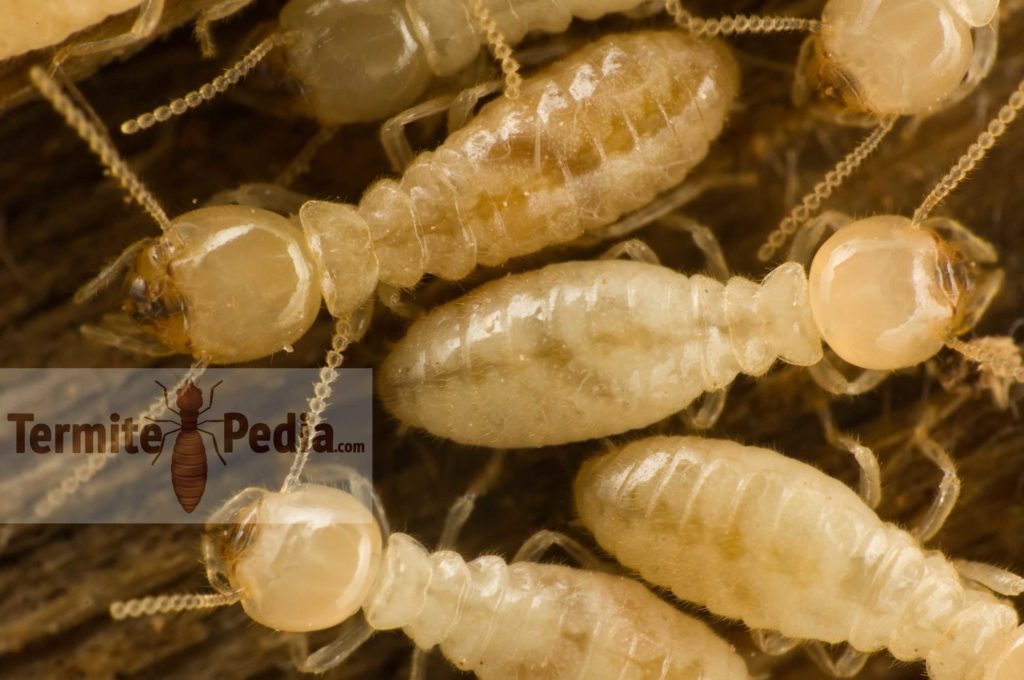
By far the most prevalent type of termite in North America is the subterranean termite also known as the soil feeding termite. This termite feeds on cotton, paper, tree and bush roots, and wood, among all the types of termites out there, the subterranean termite cause the most damage!
Subterranean termites especially enjoy the cellulose part of the wood. The Eastern Termites can have colonies up to 5 million strong wood-eating termites! Although the average is in the 30 to 40 thousand range.
The termites can be found in many parts of the building from the attic rafters to the basement foundation. You can find them by looking for the mud tubes they make, or even by finding the wings of the termite kings and queens lying about.
Eastern subterranean termites have a “swarm intelligence” which means they move and act as one entity. They swarm up during the termite season, that is, in the fall or in the spring. These termite colonies can live up to 30 years and sometimes can even exist above ground.
Make sure to keep an eye out for the termite tunnels and tubes because these swarms are not always readily visible so they can be destroying your home without you even knowing it. Make sure to look into termite prevention because it is a whole lot easier that way.
Formosan Subterranean Termites:
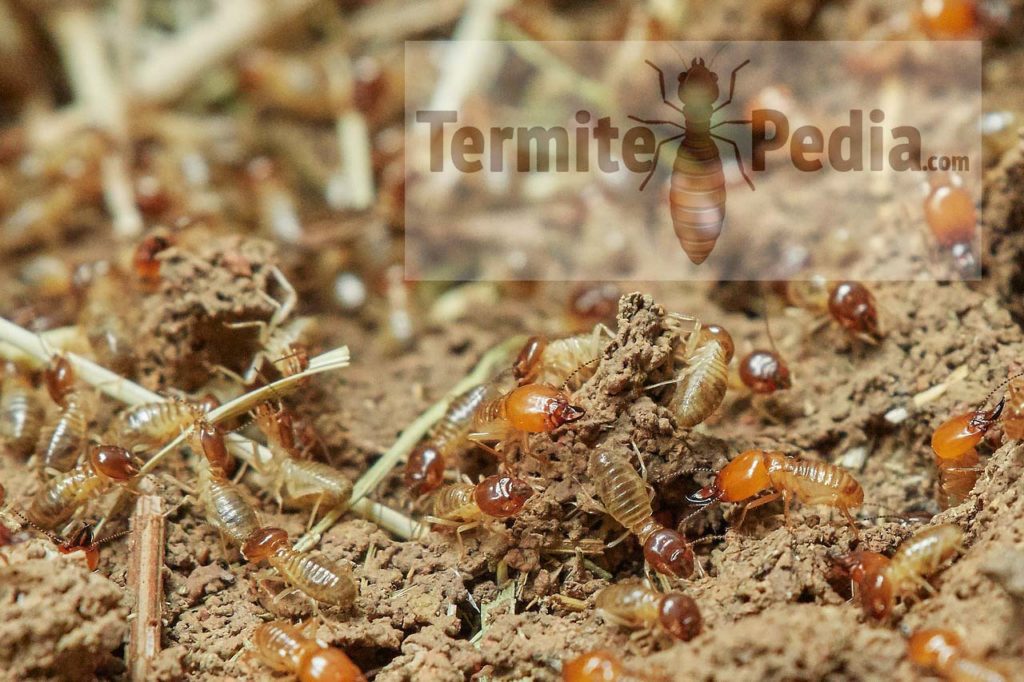
The Formosan Subterranean Termite can be found in the warmer southern climates of the United States and also in Hawaii. These termites can consume huge amounts of wood very quickly. They are the most destructive of all termites, so much so that it has been given the nickname “the super termite.”
A healthy adult colony of this type of termite can eat up to a pound of wood a day! The queen of a Formosan Subterranean Termite colony can have up to a shocking 1300 termite eggs a day.
The Formosan Subterranean Termite is a ruthless attacker and can cause more amount of property damage in the shortest amount of time than all other termite species in the United States.
These super termites have been known to eat everything from wood to plater to plastic even metal!
These termite cause their damage by eating into your walls. While they do this they use their saliva and feces to make tunnels and these tunnels make your walls bulge in places. If you see these bulging walls take immediate action because chances are you have a Formosan Termite infestation and you must call an exterminator because time is of the essence. Once again the best way to deal with termites is prevention so make sure to get your house protected.
Western Subterranean Termites:
This is by far the most common termite in the western part of the continent. The Western Subterranean Termites enter your house by squeezing through cracks in the foundation and other things.
These sneaky termites can actually squeeze through cracks as small as 1/16″ wide! They usually build their colonies underground below the frost line and above the water table.
They specifically eat the cellulose part of wood this means walls, floors, dressers, etc. The best way to notice these guys around is to look for their telltale tunnels and recognize their swarming behavior.
The thing to remember about these types of termites is where they are located in your home. They tend to do most of their damage in the basement and first floor levels of your house. They are also the urban termite in warmer climates.
Desert Subterranean Termites:
These termites are found in the dry desert climates of the southwest of the United States and into Mexico. More specifically New Mexico, Western Texas, Arizona, and Southern California.
These types of termites are unique in that they have long slender mandibles as opposed to the others which have stout wide mandibles instead.
Desert Subterranean Termites are the only termite that can burrow and feed under dry conditions. These termites make small mud tube huts that hang from wood ceilings, shelves, overhangs and the like. They as the rest of the bunch crave the cellulose part of the wood.
The important thing to take note of with the Desert Subterranean Termites is that the soldiers and workers are much smaller than the other types of termites. So they can penetrate small cracks and openings that the other termites cannot.
Drywood Termites:
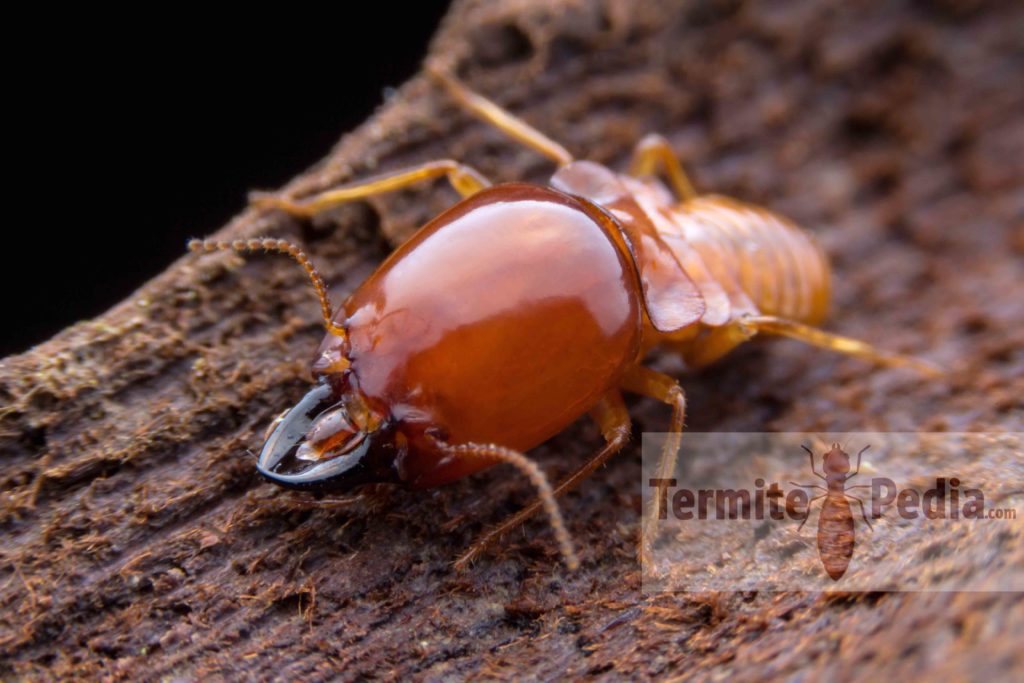
Drywood Termites get their name from the fact that they live in dry wood. Drywood infestation can occur in everything from bookshelves to wooden rocking chairs to hardwood floors and most especially, the walls of your house, pretty much anywhere there is dry wood.
There are hundreds of species of Drywood Termites. The United States only has a few. There are the Powderpost termites or more commonly known as “furniture termites“. These termites inhabit the southeast and middle parts of North America.
There is also the western Drywood Termite which mainly inhabits the western side of the United States. The typical colony of Drywood Termites is relatively small compared to the subterranean termites.
There can be multiple colonies in the same house, though unlike the subterranean termites where the colonies live in tubes and huts, Drywood Termites live in the wood and tunnel along the grain of the wood.
The best way to find the Drywood termites is to look for their telltale fecal pellets. These oval-shaped pellets have 6 concave sides and look like nothing else. Drywood Termites also leave behind finely powdered wood that looks like fine sawdust.
Other Types of Termites Worth Mentioning
- Conehead termites
- Dampwood termites
How to Identify Termites
Every type of termites has different physical properties. Make no mistake, termites are not ants and vice versa. Many people mistake termites as ants and go on with their normal daily lives, such that, by the time they are discovered as the termites they are, damages have been done, thousand dollars worth of damages.
Therefore, it’s important for every homeowner to know the difference between ants and termites and able to clearly distinguish between them.
Difference between ants and termites
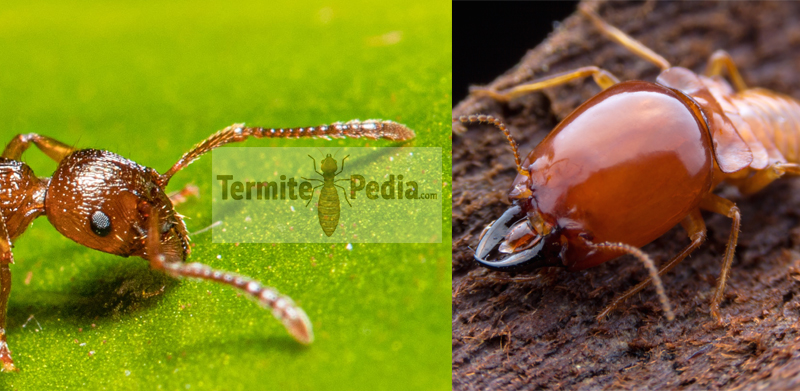
Fact is, there are physical differences between ants and termites, but they are also, at first glance, quite similar in fact in some areas termites are called “white ants”.
However, their similarities to ants are only as far as their social strata are organized, the fact that they both have organized social colonies, but, surprisingly, the termite is, in fact, a member of the cockroach or roach family, makes sense now?
Most termites are white or translucent and they are so pale that you should be able to clearly identify food present in their stomachs if you look close enough at one. An exception is the termites with wings or the winged termite which is darker. About ants, they come in different sizes and can be in any color. Ants can be in brown, dark red, green or black colors.
Physically they are not the same shape.
Termites and ants both have six legs, but the termite’s legs are short and stubby compared to their body length whilst ants’ legs are fairly long.
The body of a termite is also stocky and without any indentation, but an ant has a characteristically tapered waist. Both termites and ants can have wings, and both flying varieties have four legs.
However, the difference in their wingspan makes both ants and termites easy to differentiate.
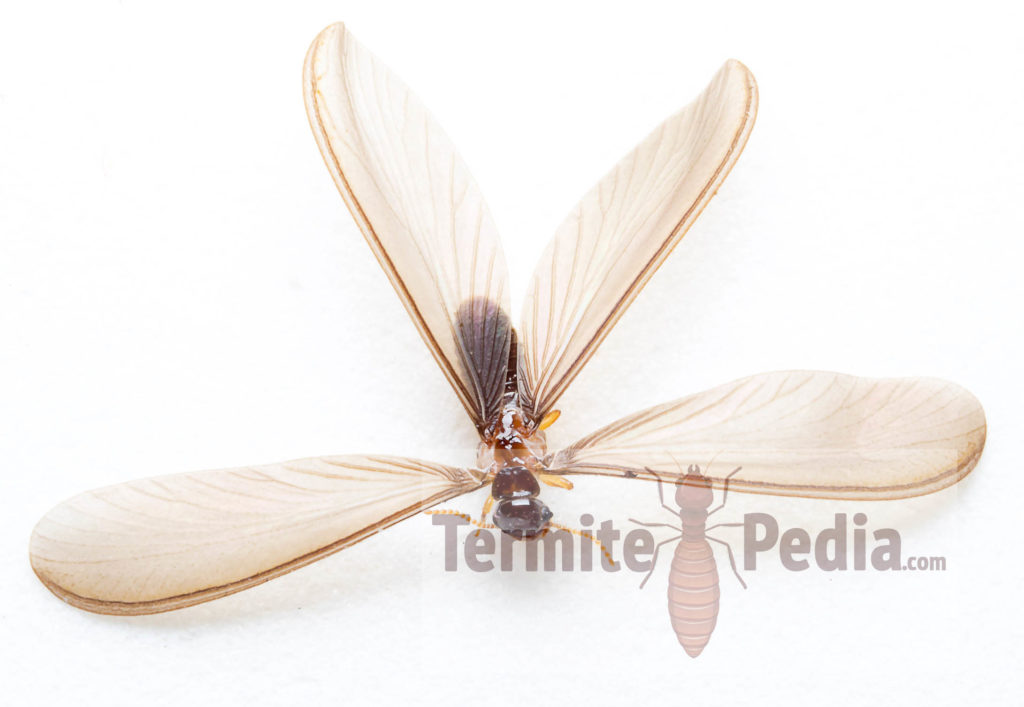
The wings on a termite are twice as long as their bodies, whilst ants are of equal length to their bodies. The wings on a termite are all the same shape and size whilst the two back wings or forewings on an ant are smaller than the front pair.
Ants have eyes which are a distinguishing characteristic, but the majority of termites do not have eyes, the exceptions are the winged termites (termites with wings), they always have eyes.
Another head difference is the shape of the antennae. The antennae on a termite are straight whilst there is a “kink” in ants’ antennae. The ants’ antennae have long segments and they are short and stubby on a termite resembling a rope of pearls. The body of an ant is harder than the soft termite body.
Ants generally do not hide away they move in clear trails in daylight. First of all, they send a few ants out to seek out a food source and once one has been located and they then send out hundreds if not thousands of ants to bring the food back to the nest.
This trail can be an inch wide, but it is never secretive it can be clearly observed, as the food hauling show goes on. On the other hand, a termite is stealthier and rarely shows itself, like a real ninja. They do venture out when they are building their nests or sending out swarmers, otherwise, they tend to live in dark hidden nests.
They hide behind a wooden façade that they do not eat so you cannot see the infestation. A giveaway can be small hard fecal pellets, but that’s only if it is a colony of dry wood termites because only the dry wood termites leave pellets, subterranean termites do not since they have liquid feces.
It’s tricky when someone doesn’t know how to identify different kinds of termites at home. Remember the differences between ants and termites? Termites belong to the roaches family as we learned from my post here, it’s easy to distinguish between ants and termites.
But that’s is just one part of it, the more difficult part is identifying the other kinds of termites from each other. how to identify different kinds of termites, that is the identification, is the first step to tackling any termite infestation because different termite colonies need different approaches for extermination!
How To Identify Different Kinds Of Termites At Home
How To Identify Different Kinds Of Termites At Home – Drywood Termites
If you live anywhere near the Gulf coast or in or around Sothern Californa Drywood Termites can big a real threat and Drywood Termite identification can be somewhat confusing.
They do not need much to survive and can live with very minimal water and are known to live in dryer climates.
Unlike their sibling the subterranean termite. You can have both of the species at once at this point you would need 2 different termite treatments to get the problem under control.
The carpenter ants are not termites, although they are also commonly misidentified as one. You will find that ants tend to flock to wooden structures as well and can look very similar to termites.
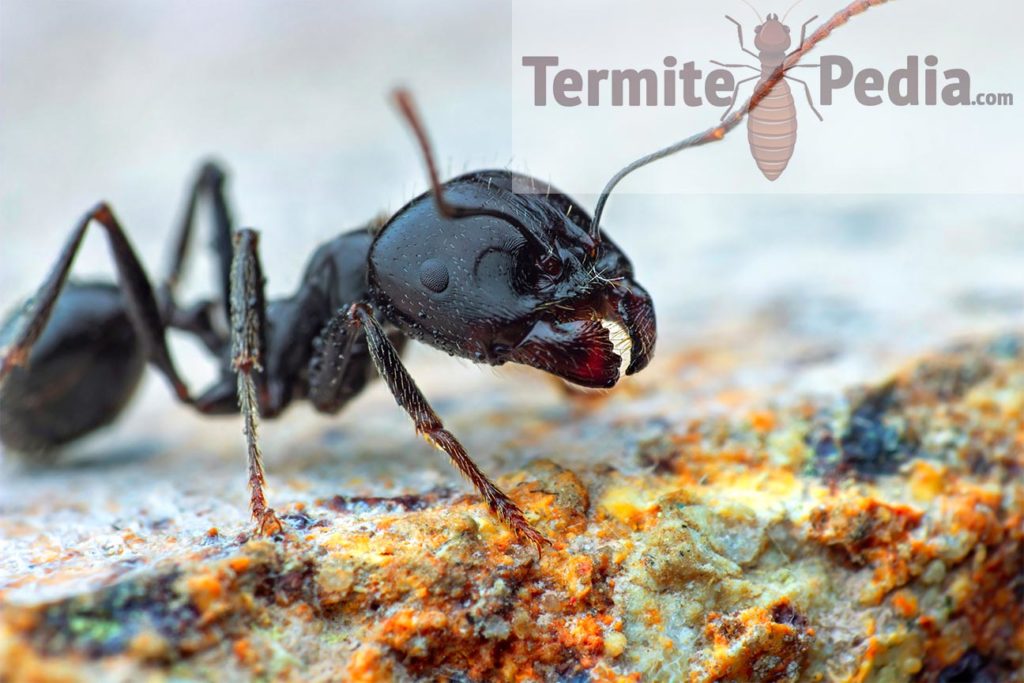
Fire ants can also be mixed in with the termites during an infestation. In order to tell the difference between these two species, you will need to get a magnifying glass to really tell the difference. They can be easily mistaken upon first glance.
The Subterranean Termite is usually colored and shaded completely black, while the Drywood Termite species are shaded and colored red, this makes drywood termite identification a little easier.
Carpenter Ants, on the other hand, can be seen in the color red, black, or brown. The Body profile of the Carpenter Ant’s body is also different from the termite because it has a thin kneck and waist, while termites longer body and the body does not close as much when messed with. It is a good idea to look at a few photos of both species at the same time to really tell the difference for yourself.
You will more than likely see worker termites, soldier termites, and swarmers if you spot an infestation in or around your home. What will be very difficult to see are the queen and king termite which will be buried deep in the nest for protection and reproduction.
How To Identify Different Kinds Of Termites At Home – Subterranean Termites
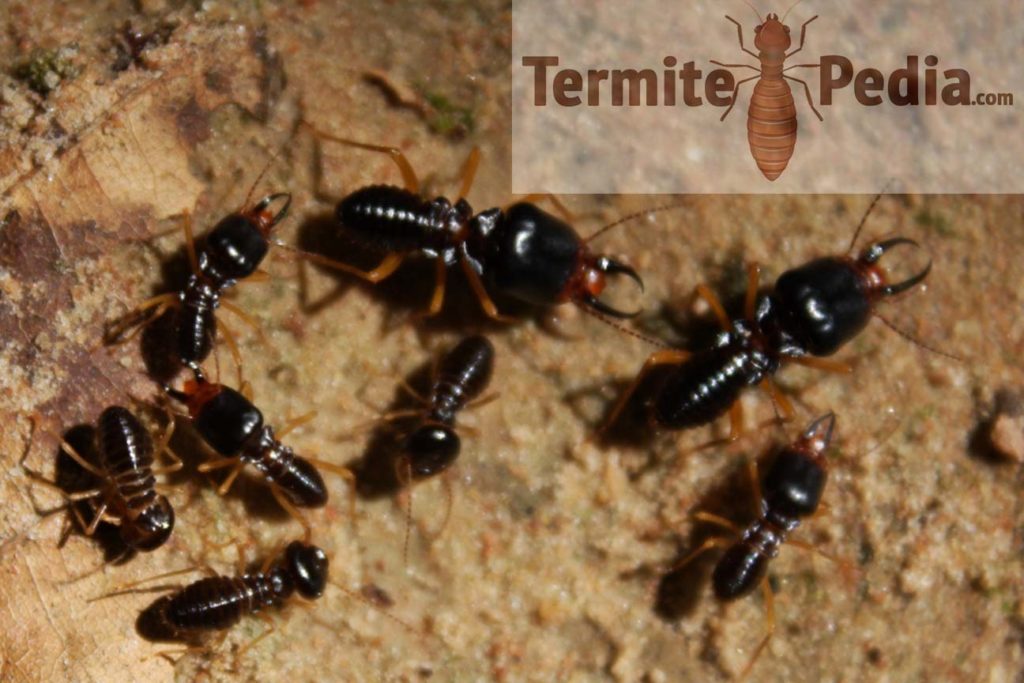
Subterranean Termites do not act in the same manner as these termites. These termites eat across the grain of the wood and dig out large tunnels that they connect to smaller chambers. The tunnels and chambers they dig out are kept very neat and tidy.
They even sometimes throw there waste outside the tunnel which can be spotted on the floor outside of the infestation. This all means that you can have fecal matter dropped into your house by these termites. Their fecal pellets are concave shaped and have round edges.
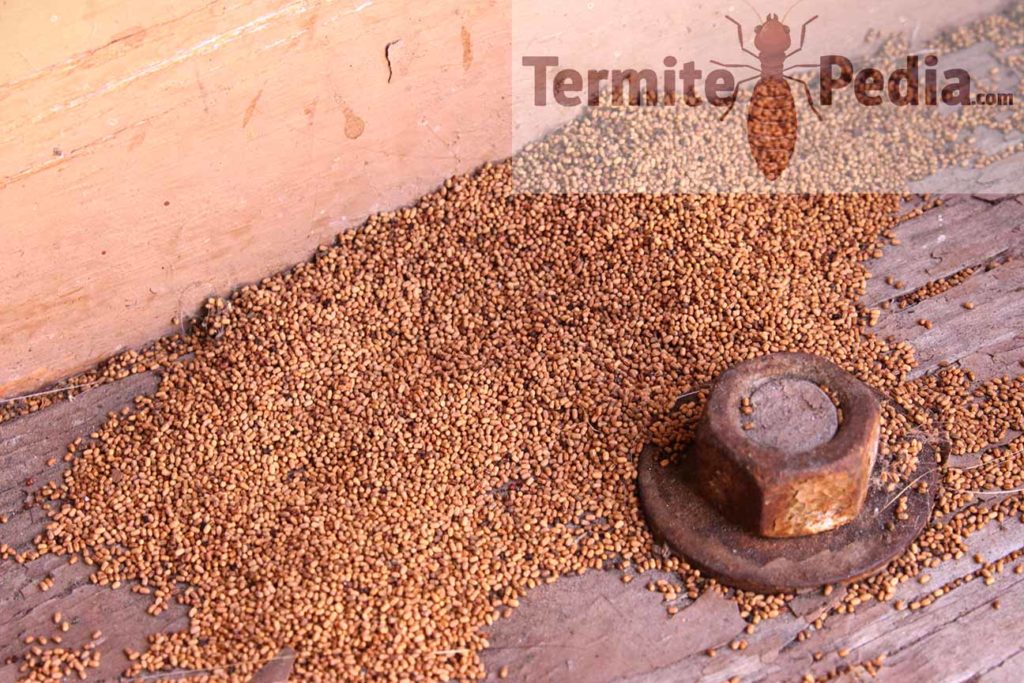
You need to remember that you can easily transfer these types of termites from a piece of wood to your home. An infested wood piece carried in from another source can carry a male and female termite, which will, in turn, create a whole new colony of termites on your property.
They do not just stay fixed the wood in your walls, the termite can go after furniture in your home as well. If you catch these colonies fast when they are small it can be a lot easier to eradicate the problem.
There are a couple of ways people go about getting rid of there termite infestations. When the job is small the more popular method of termite control is the various spot treatments. But if the job is large and the infestation has spread to your home it is usually best to get your house tented for termites.
Proper and fast Drywood identification is the name of the game. Well Identifying if you have termites in the first place is the most important step. You don’t want to get all worried if you just have a few carpenter Ants. Just remember that prevention is the best way to steer clear of a termite infestation but if you find you already have one try and cure the problem ASAP.
Flying Ants Vs Termites
Are the creatures you’re seeing in and around your home fly ants or termites? It can be hard to tell. After all, these two species of insects can look pretty similar.
You don’t want to use the wrong treatment on your bug, so it’s important to be sure of what you’re dealing with before you try to get rid of it. Let’s take a look at each of these bugs to help you figure out what you’ve been seeing.
How to Identify Flying Ants From Termites
The first thing you’ll want to look at is the antennae on these insects. Termite antennae are straight, while ant antennae are bent and segmented. However, to see this, you’ll probably have to catch some bugs and look at them under a magnifying glass. That can be difficult, so here are a few other things you can use to identify whether you have an ant or a termite.
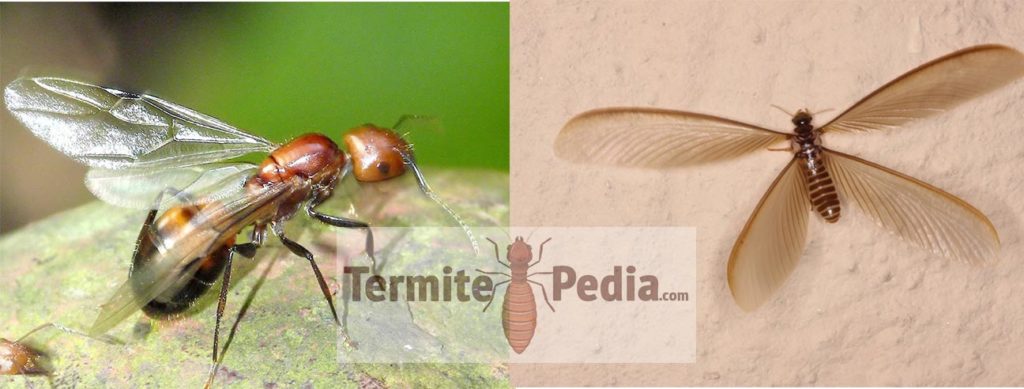
Like previously discussed, termites have fairly long wings that are the same length while flying ants have front wings that are longer than the back wings. Flying ants will appear to have three distinct body segments with very small connections – the head, thorax, and abdomen.
Termites don’t have the identifiable “waist” that ants do and look like they have just two body parts; a head and a body. You can see these differences without really getting close to the insects – a handy fact if they tend to take off when you approach.
Remember that either flying ants or termites in the yard, far from your home, don’t necessarily indicate an infestation in the house itself. If they’re close to the house, though, it might be time to worry. Ants and termites can both infest homes, though termites are more likely to cause structural damage.
Some species of ants may also damage homes while creating their colonies, but they are less likely to produce problems on the level that a thriving termite colony can create.
Termite damage can cost thousands of dollars and be difficult to repair, so taking care of a colony of these creatures quickly after proper identification is extremely important. You’ll need to get into contact with a qualified exterminator who can help you with your problems and offer the kind of advice you need. Termite treatment may not be cheap, but it’s not something you can put off. Once you’ve looked at flying ants vs. termites and determined which you have, your next step should be finding out which species of these insects you’re dealing with.
There are lots of different kinds of termites and ants in the world, thousands of them. The flying kind of each insect is an adult searching for a mate and looking to found a new colony, but the resemblances end there. Termites will be treated differently, depending on which species you’re dealing with and where it lives. Some kinds of ants, such as carpenter ants, will also be a real worry.
Different chemicals (Amazon link below) and different strategies are required for each of these kinds of insects. That’s why comparing flying ants vs termites is so important.
What Are Flying Termites (Winged Termites, swarmers)?
The kind of termites you’re most likely to see are flying termites, these are the only termites with wings in the termite colony. There are also called winged termites or swarmers since these look a lot like swarming ants.
You may see them flying around in a big cloud or crawling on surfaces. They often head towards sources of light and can get into your house through cracks in the shell or through windows. They could signal a big problem. Let’s take a look at flying termites, what they are, and what it means when you see them.

Flying termites aren’t a species of termite. Instead, they’re one of the reproductive castes that nearly every type of termite has. This class of termites is the one that does the reproducing, and which establishes new colonies. If you see them, that means there’s a termite colony somewhere near your location. If they’re heading toward your house, it’s a bad sign, since it means they might establish a colony.
However, what’s much worse is if these winged termites are seen coming out of your house and flying somewhere else. That indicates that there is a colony of termites somewhere inside the house and that real damage may be being done to your home.
If you’re in this situation, you should get in touch with a good exterminator or termite inspector right away, to find out if you have a termite problem. Once you know whether or not there are termites in your home and what kind you have, you can figure out how to deal with them.
if you’re brave enough, then you can try a DIY termite treatment, but it’s best that you let the professionals do what they are best at, that is, termite extermination!
How to prevent infestations from termites with wings (winged termite)
Now that you have learned how to identify different kinds of termites at home, you’re probably wondering how to get rid of termites at your home, but hold on, remember, if preventive measures were put in place beforehand, you wouldn’t need to learn how to identify different kinds of termites at your home.
You’re more likely to see these winged termites during the termite season, which is in the fall and spring when temperatures are on the warm side and the air is moist and not too hot. At that time, they’ll be looking for a new place to start their next colony.
Once a male and a female termite have mated, they’ll shed their wings. If they get into the house, you may see wings on the floor or around on the ground.
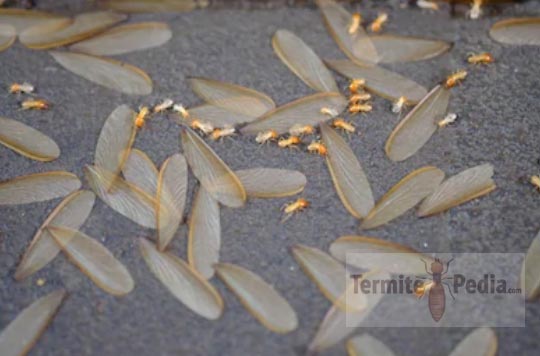
Mother nature has made it that only two termites are required to start a colony, but they generally travel in much larger groups. Swarms of thousands of flying termites have been reported, and usually, several dozen will enter a home if a large enough crack or hole is available. Not all of them will live to establish colonies, but it doesn’t take all that much to do real damage to a house.
Proven Ways On How To Prevent Winged Termite Infestation
If you want to stop flying termites from coming into your home, there are a few things you can do. Turn off lights in rooms they like to enter whenever you can, smart light switches can come in really handy in doing that.
Install a bug zapper (picture above) some distance from the house. They’ll head to the light and be killed. Of course, if you’ve seen winged termites in or around your home, you should also get in contact with someone who can check out the house. When it comes to termites, you’re better off safe than sorry.
How To Control Carpenter Ants
If you see extremely large ants around your home, you may have carpenter ants. They infest homes and can cause serious damage to wooden structures if not discovered early. Killing carpenter ants can be tricky since they make their nests in hard to find areas. If you think you may be dealing with these creatures, however, there are still things you can do. Let’s find out about how to control carpenter ants.
Things To Know About Carpenter Ants
One of the first things you should know is that carpenter ants do not eat wood, unlike termites, which can digest cellulose. Like other ants, carpenter ants eat sweets like jelly and sugar, meat, and other food residues. In the wild, they tend to feed on live or dead insects.
One of the most important things you can do (in the unfortunate scenario you didn’t learn how to control carpenter ants beforehand) when you’re considering killing carpenter ants is to deprive them of food and water. They can’t survive without them, and the colony will either die out or move on.
Carpenter ants prefer to build their nests in environments composted of moist wood. In the wild, this could be a rotting stump, a buried log, the roots of a tree or other fallen wood.
In houses, their habitat tends to be in the attic or basement, in the voids between walls, doors, curtain rods, behind tubs and bathroom tiles, in the wall, behind siding or even in insulation.
Wood found under sinks, showers, or washing machines can be a habitat for them. Keeping all wood in your home as dry as possible is an important part of preventing carpenter ants.
Carpenter ants may not eat wood, but they still create tunnels and galleries, just like termites, so learning how to control carpenter ants is extremely important.
How To Prevent Carpenter Ants Infestation
Before you have to worry about killing carpenter ants, try to keep them from taking up residence in your home, i,e. prevention.
Regularly check your entire home for signs that they’re present or for situations that might attract them.
- Get rid of routes from trees and bushes to your home.
- Seal openings where pipes and wires enter the house.
- Make sure there are no plumbing or spouting leaks.
- If you see a crack in your foundation, don’t delay repairing it.
Bugs can sometimes find them faster than we can, and you want to keep carpenter ants out.
Additionally,
- Avoid storing firewood in your home or very close by, and when you need to bring it in, look each piece over to make sure it’s free of ants.
- Remove all wet or rotten wood from the general area of your home.
- Keep drainage problems down – carpenter ants need a water source, whether it’s a clogged gutter or a leaky bathtub.
Controlling carpenter ants requires getting rid of that water source. If you convince them to move out, there’s no need to worry about killing carpenter ants.
Like many other pests, carpenter ants are mostly nocturnal. That means that you may not see them unless you’re up late, or get up very early in the morning. If you know you have them, however, you’ll need to figure out where they’re hiding.
Remember that it could be some distance from where you’ve seen them – it might even be outside. If you know where the nest is, killing carpenter ants can be accomplished with a bulb duster and an anti-insect powder (pictured above). Boric acid powders for termites are a popular method for controlling termites and carpenter ants that’s minimally toxic. Of course, if things get too bad, don’t hesitate to call a professional.
Head over to How to get rid of termites fast to learn about all the ways to kill off termites!






